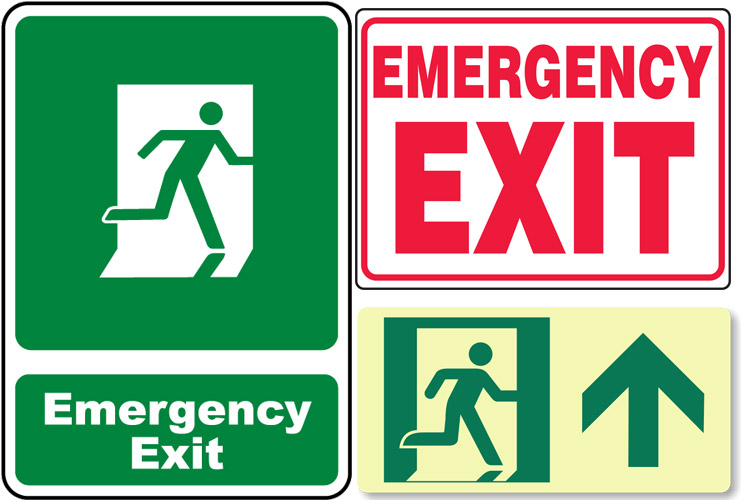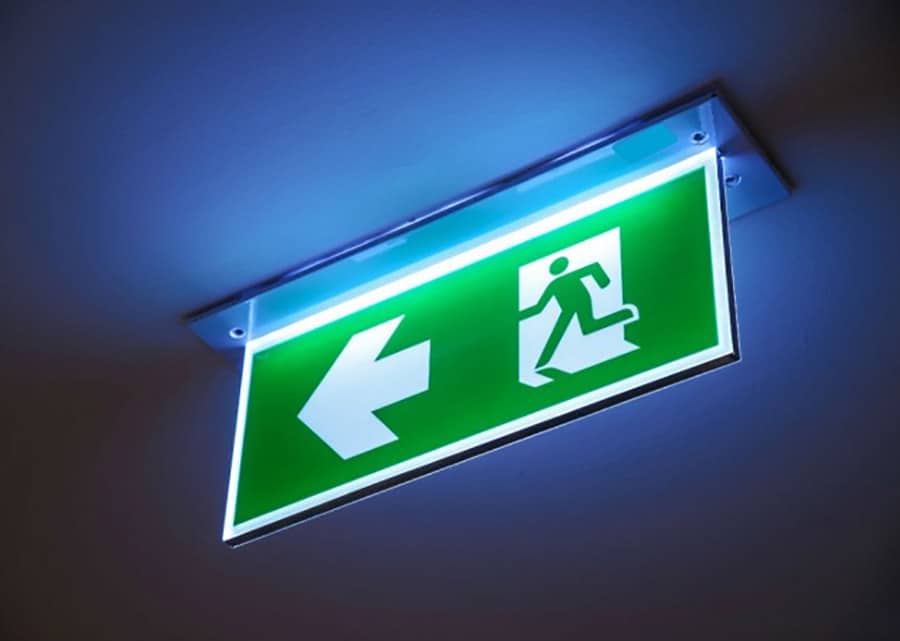Do you manage public buildings, offices, factories, or commercial spaces? If yes, you might have noticed glowing signs that show you the way out during emergency situations. These are called emergency exit signs.
In this guide, you will learn about emergency exit sign requirements and placement rules. We will also tell you how you can correctly install emergency exit signs and avoid legal issues.
Emergency Exit Signs Standards
Actually, you can not install emergency signs at random places. In fact, a team of safety experts from different organizations set the rules and regulations to install these exit signs to ensure your safety.
For example, groups like NFPA, OSHA, IBC and NEC make these standard rules for international usage. Basically, they decide things like font, letter size, board size, colors, placement, lighting and dimensions of emergency sign boards.

OSHA Exit Sign Requirements
OSHA stands for Occupational Safety and Health Administration, which provides some basic rules and regulations for protection of the public. OSHA 1910.37 rule tells you all the requirements and standards for the emergency exit sign. Some of the major standards include:
- Each exit should be easy to see with a very clear and bold text “EXIT” or visible directional arrow.
- All types of decoration pieces, charts and banners are prohibited that hide the exit sign.
- Directional arrows toward the exit should be placed at each and every portion of the building, so you always know where the exit door is.
- If there is any doorway that looks like an exit door but not an exit point, place a sign that clearly says “Not an Exit”.
- An exit sign must be bright enough so you can easily see it over a distance and even in darkness and smoke.
- The light source should give at least 5 foot candles (54 lux) of light. Moreover, bright red and green colors should be used for high visibility.
- In case of a self-luminous (the sign that glows on their own) exit sign, the level of shine is at least 0.6 footlambers which is enough for you to see in the dark.
- The word “Exit” must have an appropriate size, according to OSHA this size is approximately 6 inches (15.2 cm) tall and 1.9 cm thick.
NFPA 101 Exit Sign Requirements
The National Fire Protection Association (NFPA) works for the safety of the public in case of fire under rule 101 (life safety code) which also states regulations for exit signs, these regulations are:
- All the exit signs must have proper lighting so you can see them clearly all the time, especially in an emergency.
- Each sign has a maximum distance limit like if you are placing exit signs in the hallway then must install them after 75 to 100 feet distance. Moreover, this rule is also for directional arrows too.
- There should not be any bright sign or board near emergency signs that may confuse people during emergency evacuation. Actually, the goal is to make you spot the exit sign fastly.
- You can’t place any type of equipment, furniture and decoration piece that can hide the directional arrows and exit signs.
NEC Exit Sign Requirements
NEC stands for National Electrical Code which comes under the section of NFPA 70. Basically, it is a safety standard which is widely used to protect you from electrical hazards. It mainly includes the rules for the light sources placed at emergency exit signs.
- The power supply for emergency lights should be well designed so that even if one part fails, you don’t fall into complete darkness.
- Emergency circuits only provide power for lights and devices that are needed for emergency use. In other words, no other devices like lamps and bulbs are allowed on your emergency supply.
- Storage batteries that are connected with emergency lights should have capacity to bear the complete load of your emergency lights for at least 1.5 hours even in blackouts.
- During emergency conditions the supply of voltage should not be less than 87.5%.
- In case of a lead-acid battery that needs water, the jar must be made of a transparent material so you can check out the condition from outside.
- Automotive batteries that are used in vehicles are prohibited to use in emergency systems. Moreover, the battery must have an automatic charging system to keep it ready to use.
Emergency Exit Sign Dimensions
As we have already discussed, the emergency signs should be large enough, so that they are seen clearly. But some specific dimensions are also recommended for you by higher authorities to assure visibility.
- The word “EXIT” must be 6 inches long and ¾ (19mm) inches wide.
- The general measurement for your small emergency exit signs is 300mm in height and 150 mm in width which makes them suitable for small indoor areas.
- But if you are placing the sign board at a wide space like in a stadium, outdoor event venue and industrial area. Then sign boards with 400mm in height and 200 mm in width are preferred.
These dimensions are decided by experts after a deep analysis about the distance, view angle and locations. So, you should never ignore them if you are manufacturing or installing the exit signs.
Exit Sign Mounting Height
If we talk about the emergency exit sign height requirements, they are also described very well by NFPA, OSHA & IBC.
- According to them, exit signs should be placed at a height between 2 meters to 2.7 meters from the floor. So, you can see them easily.
- If a doorway is higher than 2.7 meters, the sign can be placed right above it.
- Any changes to this height are only allowed if approved by the relevant safety authority.
Building Code Exit Sign Requirements/IBC Exit Sign Requirements
The standards and strictness of emergency signs depend on the size of your building. If you are installing emergency signs in a large and multi storey building then always consider these points first.
- If the exit door opens toward the outside and there is a chance to be blocked by parked cars or stored items then install a barrier to make your path clear.
- Triple story buildings with the occupancy of 150 persons must have exit signs above and next to each exit door.
- In case of stairways and ramps which continue beyond the main exit level, always mark that it’s not an exit. Actually, this small step is used to help you in buildings with complex interior design.
- All the emergency lights must turn on automatically during power cuts and work for at least 30 minutes. Moreover, this backup must provide at least 10 lux brightness on the floor or steps.
When Are Exit Signs Required?
Exit signs are used where clear and safe exit routes are needed to help you. Basically, the facility managers have to install them in buildings that have 3 or more storeys with the capacity of over 150 people.
But it’s not just for buildings, all the factories, event venues, hospitals, schools, shopping malls and airports also require proper exit paths when the exit isn’t directly visible. Its main purpose is to evacuate you in case of fire, earthquake and power failure.

Emergency Exit Sign Location Requirements
Exit signs must be placed where they can clearly guide you during an emergency. Basically, their location isn’t random; it follows strict safety codes to ensure visibility and quick evacuation.
Where Do Exit Signs Need to Be Placed: Exit Sign Placement Requirements
There are some places where the placement of exit signs is very necessary for easy evacuation. Some common places are:
- Above or beside each main exit door, identify each and every exit route.
- At the top and bottom of the stairs, railings and ramps there should be an exit sign, so you don’t miss a safe way.
- Exit signs are also necessary in large corridors with multiple exit paths to identify the nearest exit door.
- As a responsible authority, always put directional arrows at hallways and intersections because these are the most confusing places.
- You can put them above the doors that lead to fire escape.
- At emergency exit gates, exit signs are a must to install.
- Near sloped walkways so the disabled persons also feel secure with these sign boards.
Do Exit Signs Need To Be Illuminated?
The answer is a big yes, emergency exit signs must be illuminated to meet IBC and NEC requirements. Basically, you can use internal or external lights according to the needs of your specific sign.
Emergency signs should remain visible even during power failures, meaning a backup power source is required to keep your sign board on for at least 30 minutes. Contractors should ensure signs meet CSA or ULC standards and provide at least 10 lux of light at floor level.
Why Are Exit Signs Red
In many countries, red exit signs are used most commonly because red is the color of danger and warning. Actually, It instantly grabs your attention and represents urgency which is important in emergencies. Moreover, it’s easy for you to see from a distance and this color also becomes prominent in smoke or low light.
Why Are Exit Signs Green
Green exit signs are also used as emergency exit signs because green is commonly linked with safety & permission. It signals you to move forward during emergencies and clearly shows the safe path for panicked persons to follow. In many countries, especially those that follow ISO standards, green is the approved color for emergency exit signage.
Emergency Exit Lights Not Working
If emergency exit lights aren’t working then it is a serious safety risk you may face legal issues for this. As a building owner, you are responsible to assure that all exit lights and signs are functional.
Basically, regular testing and maintenance are required to keep them in working condition. You should talk to an expert team for repairing faulty batteries, wirings and sign boards.
Заключительные слова
In the end, you now understand all legal requirements for emergency exit signs. If you ignore these rules, it can lead to serious safety risks and trouble for you. Hence, you should follow the exit sign standards in all cases.
If you need high-quality emergency exit signs manufacturer & supplier in China, Джеквин is your perfect partner. We offer reliable safety products and can also customize them based on your project needs.
More Helpful Resources:


-80x69.png)

